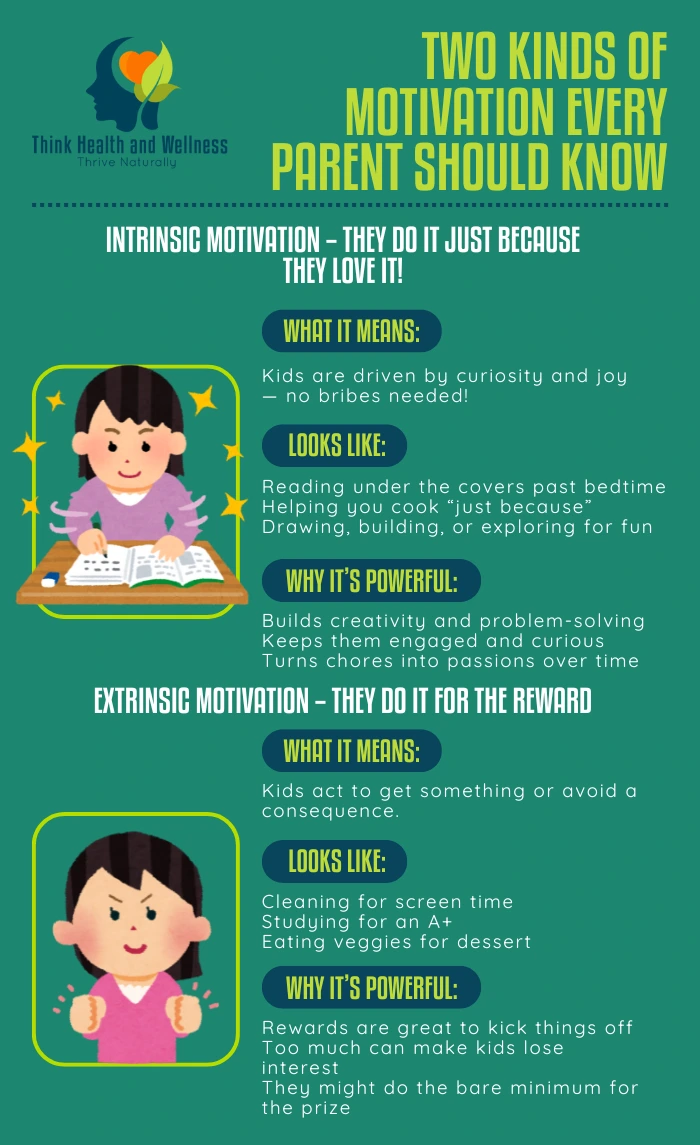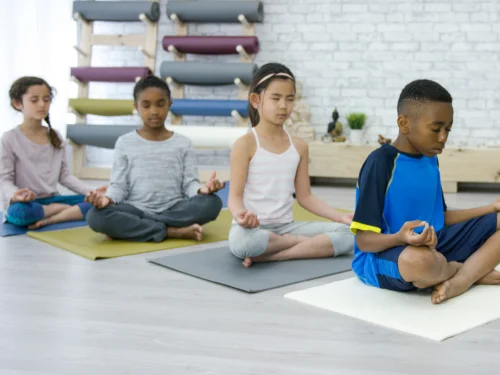Best Way to Motivate your Kids Without Pressure

Yes—finger plays, clapping games, and dance routines that use hand gestures all help. Combine rhythm and repetition for deeper learning.
Send home simple activity ideas, kits, or worksheets. Offer short instructions and encourage family involvement. Regular practice builds lasting progress.
Try origami, sticker scenes, stringing pasta, or painting with Q-tips. Crafts that use small pieces build precision and control.
Motivation is your child's "want to" factor. It's what makes them excited to build with Legos, beg for one more chapter at bedtime, or actually want to help bake cookies.
Why it matters: Motivated kids don't just do better in school, they build confidence, bounce back from setbacks, and develop a love of learning that lasts a lifetime.
If your child drags their feet at homework time or seems "checked out," you're not alone. Every parent deals with this. The good news? Motivation can be rebuilt with the right approach.
Two Types of Motivation

Intrinsic Motivation: They do it because they love it
This is when kids do something simply because they enjoy it. The kid reading under the blankets past bedtime, or begging to help cook dinner, that's intrinsic motivation. Nobody's bribing them; they genuinely want to do it.
Why it's powerful: Kids stick with things longer, get creative, and actually enjoy learning. They're not watching the clock, they're absorbed in what they're doing.
Extrinsic Motivation: Rewards and consequences
This is doing something to get a reward or avoid punishment. Cleaning rooms for screen time, studying for good grades, eating vegetables for dessert. And honestly? There's nothing wrong with using rewards sometimes, especially when you're trying to get kids started on something new or boring.
The catch: Rewards work as training wheels, but you can't rely on them forever. Over-using rewards can backfire, kids might only do the minimum to get the treat, or lose interest in things they once enjoyed.
Why is it important to instill motivation to young child?
Builds resilience
Motivated kids don't give up at the first sign of trouble. When your child is genuinely interested in building that Lego spaceship or learning to skateboard, they'll try again after falling or when pieces don't fit. Each time they push through a challenge, they're building mental muscles that say "I can handle hard things."
This persistence translates to everything: tough math problems, disagreements with friends, learning a new sport, or dealing with disappointment. Kids who've experienced the satisfaction of working through challenges develop confidence that becomes a foundation for their entire lives.
Creates lifelong learners
Here's the thing about motivation: it shapes how your child sees learning itself. A motivated child sees learning as an adventure, not a chore. They develop curiosity about the world and the confidence to explore it. This attitude doesn't just help with school, it helps kids become adults who keep growing, trying new things, and adapting to change.
Why do some kids lose motivation?

School feels boring or overwhelming
Sometimes the work is just too easy, and your bright kid is bored out of their mind coloring worksheets when they could be solving complex problems. Other times, the work is too hard, and they feel lost and frustrated. Both situations kill motivation fast.
School transitions are especially tough. Moving from elementary to middle school, changing teachers, or adjusting to a new curriculum can throw kids off balance. What worked last year might not work this year, and suddenly your formerly eager student is dragging their feet.
Learning differences and mental health challenges
If your child has ADHD, anxiety, dyslexia, or other learning differences, motivation can be extra challenging. It's not that they don't want to try, their brain just processes things differently. A child with ADHD might struggle to start tasks or stay focused. A child with anxiety might avoid trying because they're terrified of making mistakes. Kids with dyslexia might associate reading with frustration and embarrassment.
These aren't excuses, they're real obstacles that need understanding and support, not lectures about "trying harder."
Skill gaps that create frustration
Imagine being asked to bake a cake but you don't know how to crack an egg or use the mixer. You'd probably give up pretty quickly, right? Kids feel the same way when they're missing foundational skills.
If your child struggles with reading, every subject that requires reading becomes a mountain to climb. If basic math facts aren't solid, algebra becomes impossible. If they never learned how to organize their materials or manage time, keeping up with homework feels overwhelming.
These gaps create a cycle: struggle → frustration → avoidance → bigger gaps.
Breaking this cycle requires identifying what's missing and filling in those gaps patiently.
Social and emotional barriers
Peer pressure is real and powerful. Your middle schooler might think trying hard in school isn't "cool," or worry that being smart will make them unpopular.
Fear of failure can be paralyzing, some kids would rather not try at all than risk trying and failing in front of others.
Low self-esteem creates its own problems. If your child has internalized the belief that they're "just not good at school" or "not smart," they might give up before even starting.
Social isolation, feeling different from classmates, or not having friends can also drain motivation quickly.
Simple, practical strategies you can do at home

Connect learning to their passions
Does your kid love dinosaurs? Great, use that! Practice math with dinosaur problems, read books about paleontology, write stories about dinosaur adventures. Is your daughter obsessed with Taylor Swift? Have her analyze song lyrics for poetry class, calculate concert attendance for math, or research the economics of the music industry.
When kids see connections between school and their passions, suddenly homework doesn't feel like homework anymore. It feels relevant and interesting.
Gamify boring tasks
Turn mundane tasks into games or challenges. Can they beat yesterday's time for getting ready for school? Can they earn points for completing homework steps that add up to a family movie night? Create a "quest board" where daily responsibilities are framed as missions to complete.
Use timers for friendly challenges: "I bet you can't put away all the toys before this song ends!" Competition with themselves (not others) can make tedious tasks more engaging.
Celebrate effort, not just results
Instead of "Great job getting an A!" try "I'm so proud of how hard you studied this week!" Notice when your child tries something difficult, asks for help when confused, or keeps practicing even when frustrated. These process-based comments build a growth mindset, the belief that effort leads to improvement.
Make "failure" less scary by celebrating brave attempts. "You tried out for the team even though you were nervous, that took real courage!" helps kids see that trying matters more than perfect outcomes.
Give them choices
Kids are more motivated when they feel control. Offer options:
- "Math homework or reading first?"
- "Piano before or after dinner?"
- "Flashcards or make up a story for vocabulary?"
Even small choices help kids feel invested.
Break big tasks into tiny steps
A huge project or long homework assignment can feel impossible. Help your child break it down: "Let's just spend 10 minutes on the introduction today." Or "How about we solve just five math problems, take a break, then do five more?"
Celebrate each small step completed. Those little wins build momentum and make the whole task feel less overwhelming.
Create a good environment
Set up a homework space that's comfortable, well-lit, and free from distractions. Some kids focus better with quiet, others with background music. Let your child have some say in creating their study space.
Establish routines that reduce decision fatigue: homework happens at the same time each day, followed by free time. Predictability helps kids settle into tasks more easily.
Be a role model
Kids watch everything you do. Let them see you reading for pleasure, trying new things, handling your own challenges with persistence, and talking about learning. Share stories about things you struggled with and how you worked through them.
Say things like "This recipe is tricky, but I'm going to keep trying until I get it right" or "I don't understand this instruction manual yet, so I'm going to watch a tutorial."
Strategies for teachers in the classroom

Make learning relevant and real-world
Show students why what they're learning matters. Instead of abstract math problems, use real scenarios: planning a class party budget, calculating sports statistics, or designing a dream bedroom to scale. When kids see the "why," engagement skyrockets.
Offer choices in assignments
Let students choose which book to read from a list, pick between different project formats (poster, video, presentation), or select which problems to solve. Choice increases investment and allows students to play to their strengths.
Use collaborative learning
Group projects, partner work, and peer teaching tap into social motivation. Kids often engage more when working with classmates. Just be thoughtful about groupings and ensure all students contribute.
Provide immediate, specific feedback
Instead of waiting weeks to return graded work, give quick feedback on small assignments. Be specific: "Your thesis statement is clear and interesting" is more motivating than just "Good work." Feedback helps students see their progress and know what to work on next.
Build relationships
Students are more motivated for teachers who know them, care about them, and believe in them. Learn about their interests, check in about their lives, and show genuine enthusiasm for their growth. Kids work harder for teachers they feel connected to.
You May Also Like: 6 Different Types of Attention Every Parent Should Know
When to get professional help

Sometimes motivation issues signal something bigger that needs professional help. Consider reaching out to a counselor, therapist, or educational specialist if:
- Your child's lack of motivation is accompanied by sadness, withdrawal, changes in sleep or appetite, or talk of hopelessness
- Motivation problems persist despite your best efforts for several months
- You suspect learning disabilities, ADHD, or other conditions that need diagnosis and support
- Your child's struggles are affecting their self-esteem, friendships, or family relationships
- School refusal or extreme anxiety around learning develops
Don't wait until things are in crisis. Early intervention makes a huge difference, and there's no shame in getting help. Sometimes kids need more than what parents and teachers alone can provide.
You May Also Like: What Is Child-Rearing? (Parenting Styles and Practices Explained)
Conclusion
Motivating kids isn't about constant praise or demanding perfection. It's about understanding what drives your unique child, removing barriers, and creating conditions where motivation can grow.
Remember: Motivation ebbs and flows. Even motivated kids have off days. That's normal. The goal isn't a child who loves everything all the time, but building resilience, curiosity, and the belief that effort matters.
Start small: Pick one or two strategies and try them for a few weeks. Pay attention to what works for your specific child. Be patient.
You're not just getting tonight's homework done, you're helping your child develop attitudes and skills for a lifetime. And that's worth every bit of effort.
You May Also Like: When Undisciplined Kids Grow Up: Why Habits Matter




